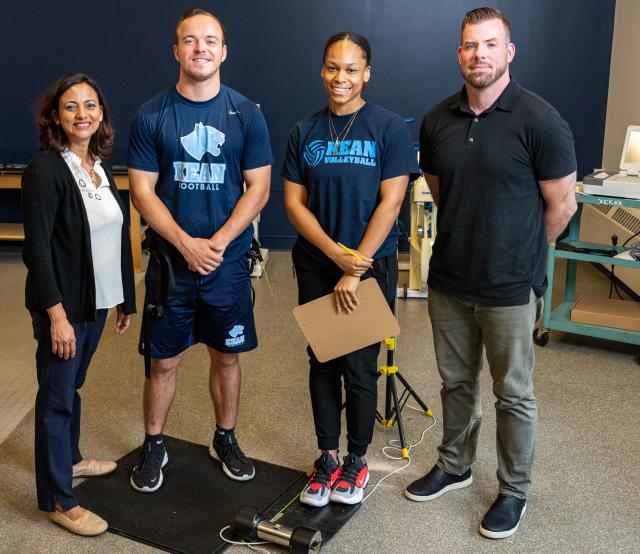Kean University Researchers, Student-Athletes Partner to Study Calcium Intake and Cardiovascular Health

A collaborative study involving Kean University’s student-athletes and researchers is one of the first to examine the importance of calcium to cardiovascular health, opening new pathways for future scientific discovery.
“The importance of calcium has been well established in bone health,” said lead author Pragya Sharma, Ph.D., an assistant professor in Kean’s Department of Health and Human Performance. “This is one of the first to show how calcium relates to cardiovascular performance, as well as overall muscle performance.”
Published in the journal Sports, the study found that calcium played a significant but contradictory role in cardiovascular performance.
Athletes from Kean’s baseball, lacrosse and soccer teams volunteered as research participants in the Human Performance Laboratory, where they underwent various tests, including jumping, grip strength, push-ups and running on a treadmill. The study found that athletes who reported consuming more calcium were able to complete more push-ups but had lower endurance on the treadmill.
Calcium-rich foods include dairy products, cereals, nuts and vegetables. Cereals and juices are often fortified with calcium.
Sharma and collaborator Adam Eckart, D.H.Sc., also an assistant professor in Kean’s Department of Health and Human Performance, plan to continue studying calcium’s role in athletic performance.
“One unexpected finding in our study was that calcium could be a marker for energy expenditure, resulting in downstream effects on body composition,” Eckart said. “We could look at whether calcium intake affects energy expenditure.”
The researchers also found variations in calcium intake among athletes based on their sport.
“Calcium is a micronutrient, and its role in athletic performance is often overlooked as we focus on macronutrients,” Sharma said. “Athletes know that carbohydrates, proteins and fats play a major role in overall performance. But they don’t pay attention to micronutrients.”
Lacrosse players consumed significantly more calcium than baseball or soccer players in the study. Baseball and soccer players did not meet the recommended daily intake of 1,000 mg of the micronutrient, the study showed. This suggests a potential need for enhanced education on nutrition, Sharma said. The study's timing may have influenced calcium intake patterns, as it was conducted during soccer season when players typically increase their carbohydrate consumption for optimal energy levels.
Another surprising finding was that athletes with better left-hand grip strength – mostly baseball and lacrosse players – also demonstrated better overall muscle performance. This could be due to the dual dexterity needed in both sports, Eckart said.
Baseball players outperformed others on all assessments, likely due to the sport's demands for power and speed in hitting, throwing and sprinting. Differences in lean body mass and body fat percentages across sports reflect their unique physical demands—lacrosse, for instance, requires both stability for contact and agility for speed. These sport-specific needs shape training and nutrition strategies, influencing the variations observed in this study.
“This study is a prime example of the powerful collaborations taking place across the Kean community,” said James F. Konopack, Ph.D., dean of Kean’s College of Health Professions and Human Services. “Through this project, our faculty researchers also provided students with valuable hands-on data analysis experience, while our student-athletes actively participated in addressing questions that affect their health. These partnerships showcase Kean’s expanding profile as a national R2 research institution.”
Two students involved with conducting the study have already gone on to pursue advanced degrees and continue their research careers. Xiyan Ding, a graduate assistant at the time, is listed as a co-author for his contribution to data analysis in the paper and has applied to doctoral programs. Another undergraduate student who assisted with data collection is now pursuing a master’s degree in Louisiana.
“I’m very thankful for the Center for Undergraduate Research and Fellowships for providing an opportunity for students to contribute to this research,” Sharma said.